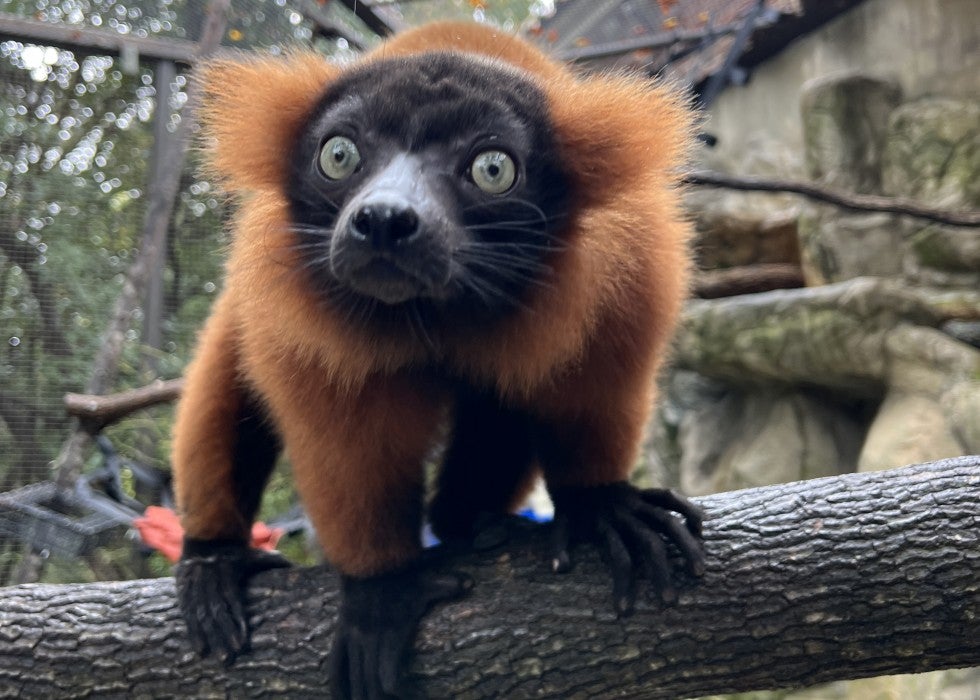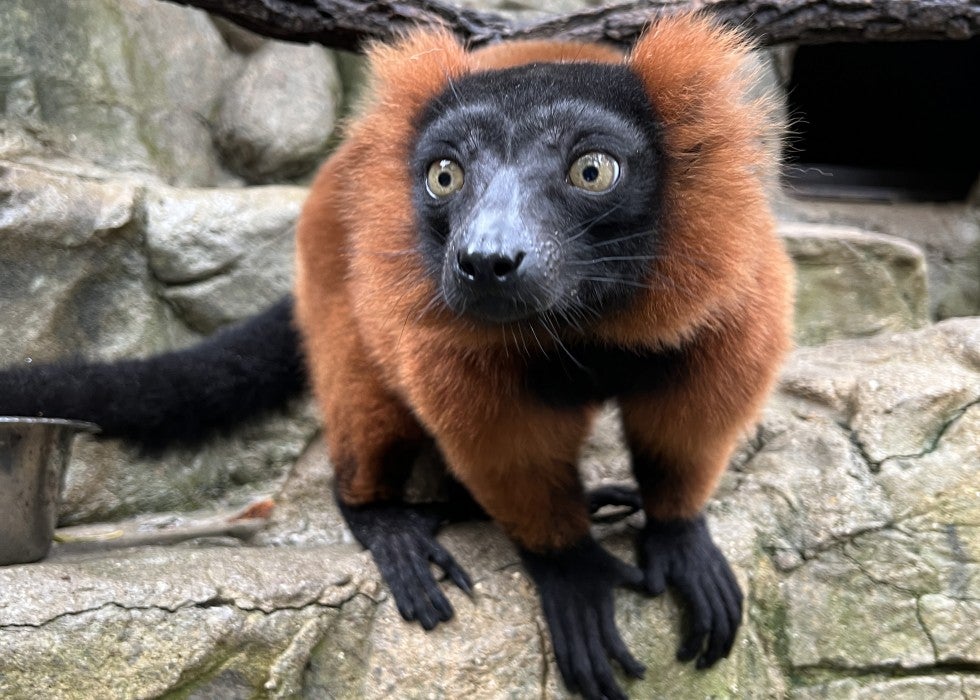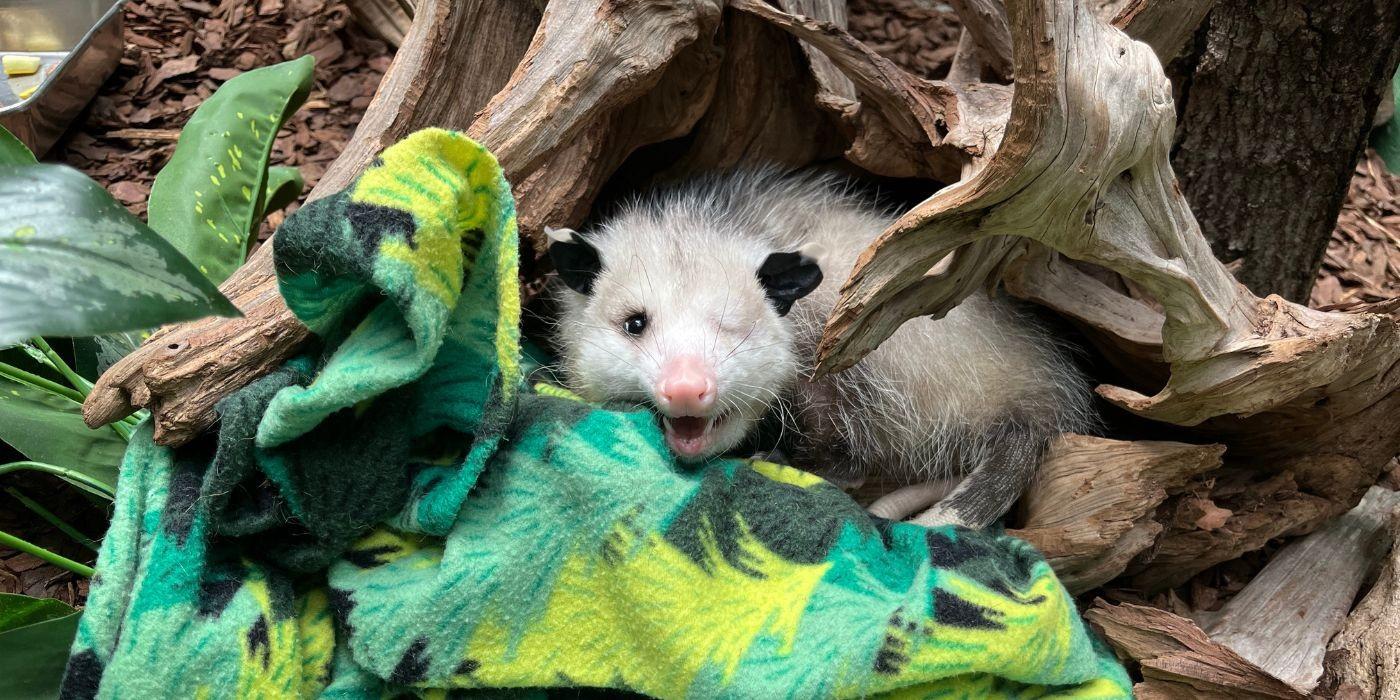Meet the Zoo’s Lemurs

Big bright eyes, bounding leaps and vivacious vocalizations—there’s no denying that lemurs are downright adorable! Every October, we celebrate World Lemur Day to raise awareness of these endangered primates from Madagascar. Meet our animal ambassadors—and learn how you can help their wild cousins—in this update from our Primate and Small Mammal House keepers.
Leap onto Lemur Island with assistant curator of primates Emily Bricker for an up-close look at our animal ambassadors! In this talk, Emily conducts a training session with ring-tailed lemur Southside Johnny, demonstrates feeding techniques with black-and-white ruffed lemurs Wiley and Aloke, and shares how you can help lemurs in Madagascar.
Meet Our Ring-Tailed Lemurs
Native to the spiny scrub forests of southern Madagascar, ring-tailed lemurs are easily recognizable for their black-and-white striped tails. In the wild, they can live in groups of up to 30 individuals, and all females in the group are dominant over the males—a trait not often found in other primate species.
Here at the Zoo's Lemur Island exhibit, our four ring-tailed lemur boys have a hierarchy of their own!
Bowie is the most dominant of our ring-tailed lemurs, and he often reaps the rewards of being in charge. He has a bold personality, which is evident whenever we give the group enrichment items. Bowie will wait for the other lemurs to figure out the puzzle feeders first before swooping in and taking the treats for himself!
Next comes Southside Johnny, who is easy to spot with his striking dark, orange eyes. He also has a small white “V” at the edge of the gray hair on his forehead. Johnny is a star during husbandry training sessions with his keepers, especially when he is asked to show off his jumping skills.
Next comes Birch. At 13 years old, he is the oldest of our ring-tailed lemurs. (Bowie, Southside Johnny and Tom Petty are all 12 years old.) He can be very shy and is often wary of new things, but he has a social butterfly streak, too. He gets along very well with the other ring-tailed lemurs and can often be seen huddling and grooming with the group.
Last—but certainly not least—comes Tom Petty! As the least dominant individual, he prefers to stay back to allow his fellow troop members the opportunity to forage. When they are done, Tom sneaks in and takes all of the leftovers! Tom has a unique and distinguished look about him. One easy way to tell him apart from the others is by looking closely at the markings on his head; there is plenty of white space between his black eye rings and the gray hair on top of his head.
Meet Our Collared Brown Lemurs
Collared brown lemurs, like ring-tailed lemurs, typically form large troops consisting of two to 22 lemurs. Unlike the ring-tailed lemurs, however, they do not have a hierarchical structure; males and females can be co-dominant. You can tell our 5-year-old collared lemur brothers apart by looking at the color of their collars: Bentley’s is more orange, whereas Beemer’s is more cream. You can see them at the Small Mammal House's outdoor exhibits on fair weather days!
Bentley is much braver than Beemer. He tends to lead his brother through new situations by exploring them first. His adventurous side makes him a pro at figuring out enrichment items that are more challenging.
Beemer can be quite timid with new situations. When he starts to feel more comfortable, he is very curious and sweet.

Meet Our Black-and-White Ruffed Lemurs
Black-and-white ruffed lemurs tend to stick to smaller groups of two-to-five individuals. Occasionally, groups of up to 16 individuals have been seen when food is readily available. Aloke and Wiley can be seen in the treetops of Lemur Island, and their booming calls can be heard around the Zoo!
At 13 years old, Wiley is the younger of our two black-and-white ruffed lemurs. He is very outgoing and likes to be right in the middle of all the action. True to his name, Wiley is often the goof of the group. He can be a bit clumsy, sometimes, and tends to trip over his feet—but that just adds to his charm!
Black-and-white ruffed lemur Aloke, who is 14 years old, has a feisty streak. He is very smart and enjoys participating in husbandry training sessions. Aloke tends to follow keepers around, just in case they have a special treat for him!
Meet Our Red Ruffed Lemurs
Red ruffed lemurs can understand the alarm calls of black-and-white ruffed lemurs, even though they are from different parts of Madagascar!
Female red ruffed lemurs are dominant over males. As the only female red ruffed lemur, 14-year-old Molly is the boss of the Small Mammal House's troop. She keeps the three boys in their place! Molly tends to be cautious in approaching new things, but once she deems it okay, she’s eager to investigate.
Coronado, also 14 years old, is the most cautious of the red ruffed lemurs and is usually the first to start vocalizing if something “looks suspicious.” However, he is always eager to participate in a training session, even if it takes him a bit to realize what behavior keepers are asking him to do. Coronado is the only lemur in this troop with blue eyes.
Cortes is Coronado’s brother and is also one of the first to engage in a training session. Cortes is the calmest of the four but does assert his dominance on occasion. He is thoughtful about approaching enrichment and always eager to figure out what it is. His furrowed brow over his amber eyes always makes him look like he is deep in thought.
Both Cortes and Coronado received a recommendation to breed with Molly. In 2016, Molly gave birth to three babies!

Black-and-white ruffed lemurs' back feet have a grooming claw, also known as a toilet claw.
How do lemurs socialize?
Social grooming is one way that lemurs strengthen bonds between individuals and groups. Lemurs have built-in grooming tools! They remove debris from their fur using an adaptation called a “tooth comb”—special teeth at the front of their jaw that jut out at an angle.
What happens if hair gets stuck in a lemur’s tooth comb? There’s an adaptation for that, too! Lemurs have a second tongue—called the “sublingua”—that is used to remove debris from the tooth comb. The sublingua is smaller than the primary tongue, sits below it and lacks taste buds.
A tooth comb isn’t the lemurs’ only grooming tool. While for the most part their fingernails and toenails look just like ours, one of the toes on their back feet has a longer, pointed claw. All lemurs have a grooming claw, but the digit on which it is found varies among species.
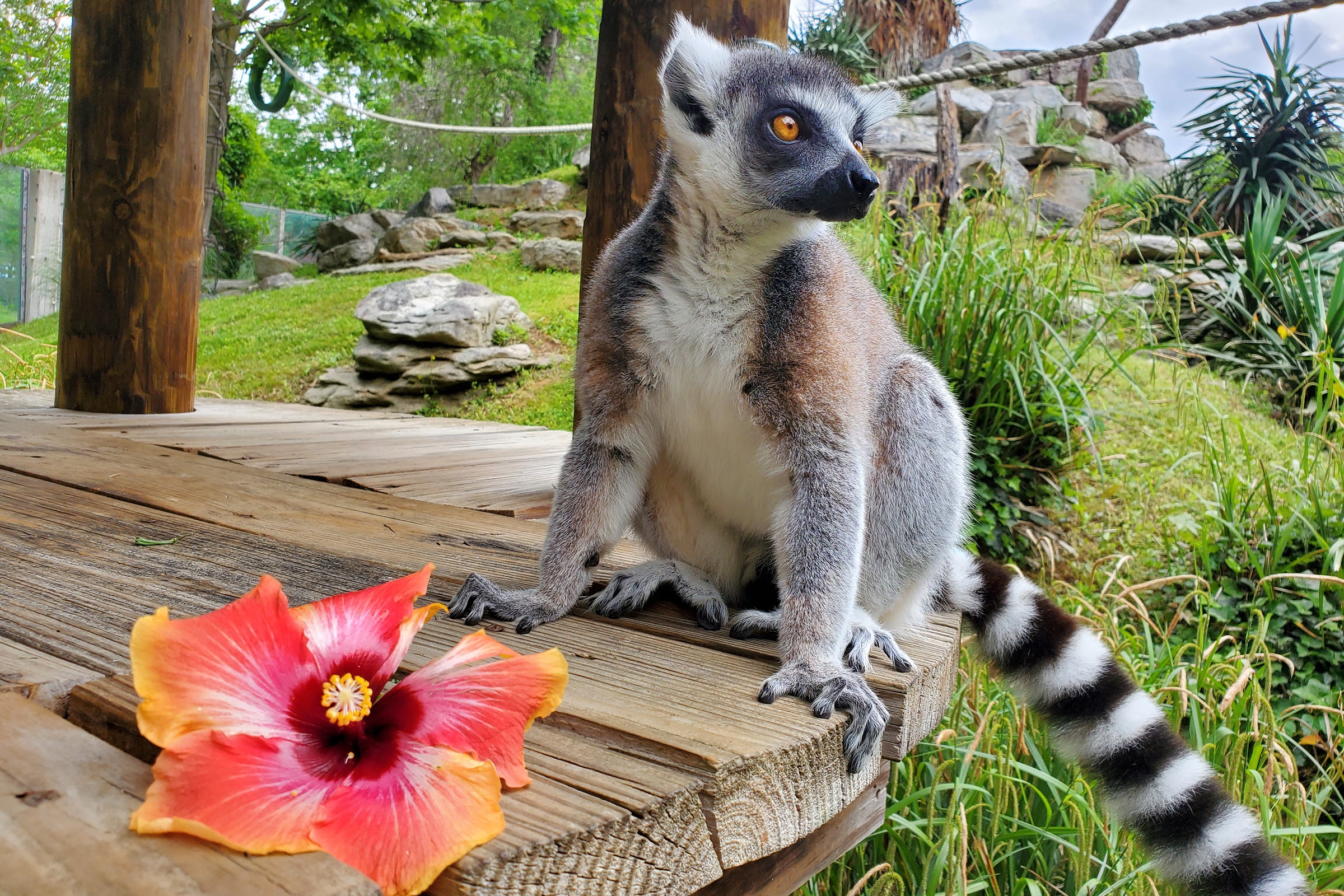
Ring-tailed lemur Southside Johnny.
Sights
Ring-tailed lemurs get their name from one of their most prominent features: the 13 alternating black-and-white stripes on their tail! This eye-catching pattern can act as a visual aid for troop members who are trying to navigate through thick bushes.
They also use facial expressions to communicate. Are their eyes wide or relaxed? Are they showing or covering their teeth? If a lemur’s eyes and mouth are open wide, but its lips are covering its teeth, this can be a threatening gesture. On the other hand, if their eyes are relaxed and they are showing their teeth, it may be a friendly behavior. Keepers can use these expressions to better understand lemur group dynamics and social structure.
Listen to red ruffed lemurs Molly, Coronado and Cortez alarm call!
Sounds
Lemurs make a variety of vocalizations. To warn others of a predator or potential threat, they will alarm call. When they want to bond with their group members, they sound contact or cohesion calls. And, when ruffed lemurs are frustrated, they make a huffing noise—just like us!
Ring-tailed lemurs can make over 20 different vocalizations. At Lemur Island, primate keepers are learning to differentiate individual calls to aid in the lemurs’ care. For example, if the lemurs are frequently alarm calling, that can indicate a predator, like a snake, is present. Then, keepers can inspect and remove the potential threat.
A curious ‘eep’ vocalization can mean that we are enriching them properly and encouraging their natural behaviors. A frustrated ‘huff’ can mean that their enrichment is too hard to figure out, or that another lemur is bothering them. Keepers can’t always tell what they are vocalizing about, but the more we listen and watch, the more we can interpret their communications.
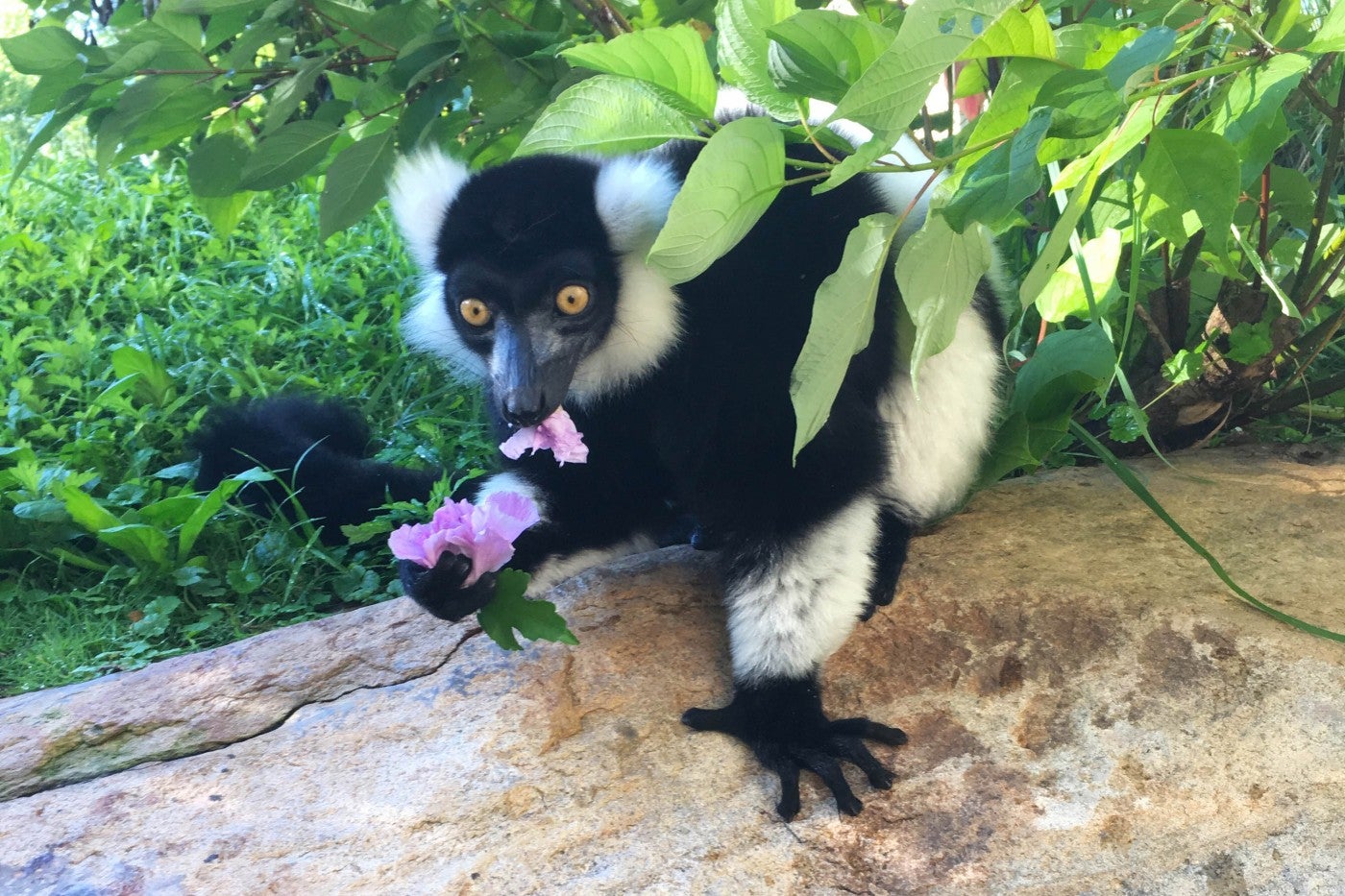
Aloke feasts on a hibiscus flower. Black-and-white ruffed lemurs are some of the most prominent pollinators in their native Madagascar!
Where do lemurs live in the wild?
Madagascar is home to about 100 different lemur species, and each have their own unique characteristics, habitat, diet, social structure and locomotion. Some lemurs have long hind limbs for jumping and leaping, while others have specialized tongues that help them feed on nectar.
How did this diverse array of species arise on such a small island? Madagascar’s ecological landscape ranges from lush tropical rainforests to scrublands and arid deserts. Without the presence of other primate species to compete for resources, lemurs were able to adapt and fill these ecological niche environments. Nearly 90% of Madagascar’s plants and animals are endemic—you won’t find them anywhere else in the world!
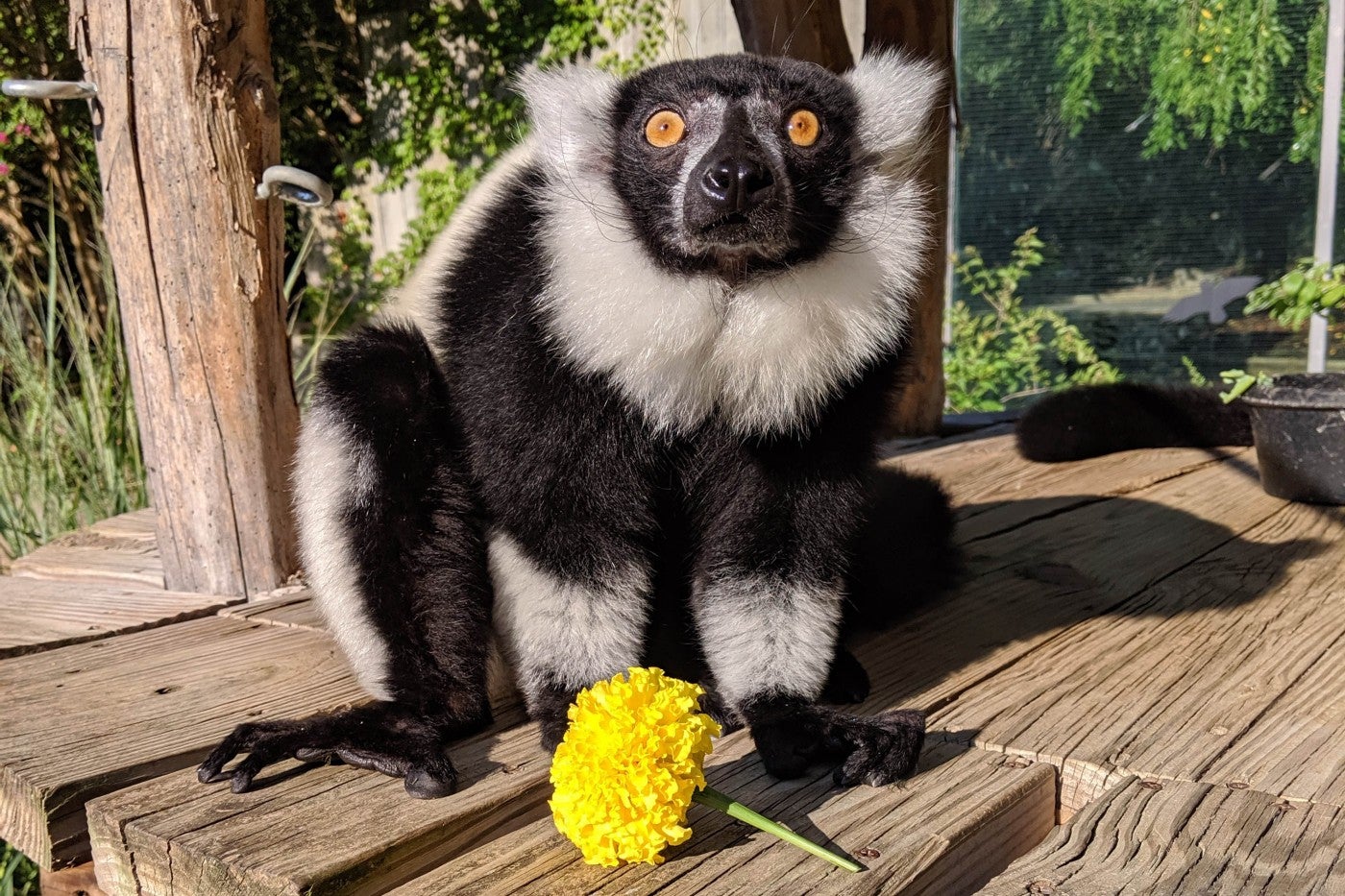
What threats do lemurs face?
As charismatic and lovable as lemurs are, they face an uncertain future. Nearly all lemur species—98%—are considered either endangered or critically endangered by the International Union for Conservation of Nature.
Their native habitats are cleared for agricultural use; they are illegally poached for food or the pet trade; they are susceptible to disease from invasive pets and pests; and climate change has caused severe droughts in south Madagascar and typhoons in the north.
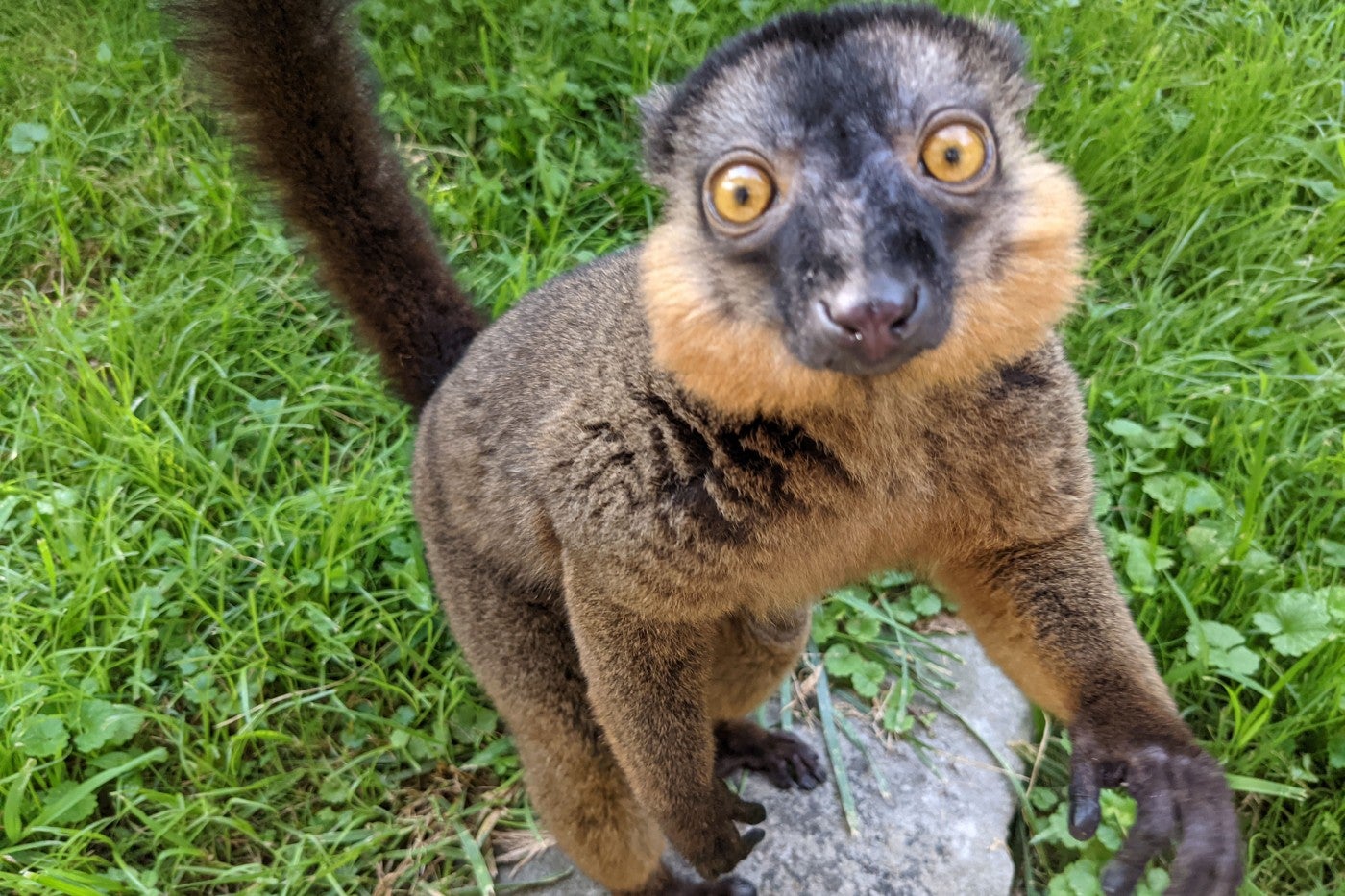
Collared brown lemur Bentley. Since 1997, collared lemur populations have declined more than 50% in their native Madagascar.
I want to help lemurs! What can I do?
The good news is that you can help conserve these amazing, unique primates! Learning about lemurs (and sharing that knowledge with family and friends) is a great first step.
To save lemurs, we must help lemur habitats in Madagascar. Be a smart consumer: prioritize purchasing sustainably sourced wood furniture, decorations and musical instruments to avoid illegally logged and exported wood from Madagascar. You can also visit Madagascar; ecotourism will financially help lemur conservation in the country.
Lemurs are very cute, but they are not pets. Avoid photo opportunities with lemurs, and refrain from liking or sharing videos that depict them as pets. Remember that they are wild animals and should only be housed in reputable facilities with trained staff that can meet their social, mental, physical and nutritional needs.
Last but not least, you can help lemurs by taking a trip to Smithsonian’s National Zoo! The money that you spend on parking, food and merchandise (and any donations you make) helps support our animal care and conservation programs.
Thank you for celebrating World Lemur Day with us! During your next visit, we hope you stop by the Small Mammal House and Lemur Island to see these amazing primates in person.
Want to leap into more lemur stories? Learn how primate keepers train lemurs to voluntarily participate in radiographs in this update. And, don't miss five reasons to leap into World Lemur Day!
This story was updated Sept. 26, 2023.

